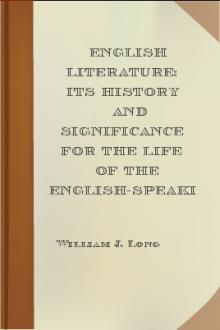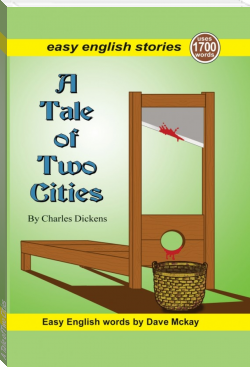English Literature: Its History and Significance for the Life of the English-Speaking World by William J. Long (good books for 8th graders txt) 📕

- Author: William J. Long
- Performer: -
Book online «English Literature: Its History and Significance for the Life of the English-Speaking World by William J. Long (good books for 8th graders txt) 📕». Author William J. Long
A Dutch traveler, Johannes de Witt, who visited London in 1596, has given us the only contemporary drawing we possess of the interior of one of these theaters. They were built of stone and wood, round or octagonal in shape, and without a roof, being simply an inclosed courtyard. At one side was the stage, and before it on the bare ground, or pit, stood that large part of the audience who could afford to pay only an admission fee. The players and these groundlings were exposed to the weather; those that paid for seats were in galleries sheltered by a narrow porch-roof projecting inwards from the encircling walls; while the young nobles and gallants, who came to be seen and who could afford the extra fee, took seats on the stage itself, and smoked and chaffed the actors and threw nuts at the groundlings.[133] The whole idea of these first theaters, according to De Witt, was like that of the Roman amphitheater; and the resemblance was heightened by the fact that, when no play was on the boards, the stage might be taken away and the pit given over to bull and bear baiting.
The StageIn all these theaters, probably, the stage consisted of a bare platform, with a curtain or "traverse" across the middle, separating the front from the rear stage. On the latter unexpected scenes or characters were "discovered" by simply drawing the curtain aside. At first little or no scenery was used, a gilded sign being the only announcement of a change of scene; and this very lack of scenery led to better acting, since the actors must be realistic enough to make the audience forget its shabby surroundings.[134] By Shakespeare's day, however, painted scenery had appeared, first at university plays, and then in the regular theaters.[135] In all our first plays female parts were taken by boy actors, who evidently were more distressing than the crude scenery, for contemporary literature has many satirical references to their acting,[136] and even the tolerant Shakespeare writes:
Some squeaking Cleopatra boy my greatness.However that may be, the stage was deemed unfit for women, and actresses were unknown in England until after the Restoration.
Shakespeare's Predecessors in the Drama. The English drama as it developed from the Miracle plays has an interesting history. It began with schoolmasters, like Udall, who translated and adapted Latin plays for their boys to act, and who were naturally governed by classic ideals. It was continued by the choir masters of St. Paul and the Royal and the Queen's Chapel, whose companies of choir-boy actors were famous in London and rivaled the players of the regular theaters.[137] These choir masters were our first stage managers. They began with masques and interludes and the dramatic presentation of classic myths modeled after the Italians; but some of them, like Richard Edwards (choir master of the Queen's Chapel in 1561), soon added farces from English country life and dramatized some of Chaucer's stories. Finally, the regular playwrights, Kyd, Nash, Lyly, Peele, Greene, and Marlowe, brought the English drama to the point where Shakespeare began to experiment upon it.
Each of these playwrights added or emphasized some essential element in the drama, which appeared later in the work of Shakespeare. Thus John Lyly (1554?-1606), who is now known chiefly as having developed the pernicious literary style called euphuism,[138] is one of the most influential of the early dramatists. His court comedies are remarkable for their witty dialogue and for being our first plays to aim definitely at unity and artistic finish. Thomas Kyd's Spanish Tragedy (c. 1585) first gives us the drama, or rather the melodrama, of passion, copied by Marlowe and Shakespeare. This was the most popular of the early Elizabethan plays; it was revised again and again, and Ben Jonson is said to have written one version and to have acted the chief part of Hieronimo.[139] And Robert Greene (1558?-1592) plays the chief part in the early development of romantic comedy, and gives us some excellent scenes of English country life in plays like Friar Bacon and Friar Bungay.
Methods of the Early DramatistsEven a brief glance at the life and work of these first playwrights shows three noteworthy things which have a bearing on Shakespeare's career: (1) These men were usually actors as well as dramatists. They knew the stage and the audience, and in writing their plays they remembered not only the actor's part but also the audience's love for stories and brave spectacles. "Will it act well, and will it please our audience," were the questions of chief concern to our early dramatists. (2) Their training began as actors; then they revised old plays, and finally became independent writers. In this their work shows an exact parallel with that of Shakespeare. (3) They often worked together, probably as Shakespeare worked with Marlowe and Fletcher, either in revising old plays or in creating new ones. They had a common store of material from which they derived their stories and characters, hence their frequent repetition of names; and they often produced two or more plays on the same subject. Much of Shakespeare's work depends, as we shall see, on previous plays; and even his Hamlet uses the material of an earlier play of the same name, probably by Kyd, which was well known to the London stage in 1589, some twelve years before Shakespeare's great work was written.
All these things are significant, if we are to understand the Elizabethan drama and the man who brought it to perfection. Shakespeare was not simply a great genius; he was also a great worker, and he developed in exactly the same way as did all his fellow craftsmen. And, contrary to the prevalent opinion, the Elizabethan drama is not a Minerva-like creation, springing full grown from the head of one man; it is rather an orderly though rapid development, in which many men bore a part. All our early dramatists are worthy of study for the part they played in the development of the drama; but we can here consider only one, the most typical of all, whose best work is often ranked with that of Shakespeare.
CHRISTOPHER MARLOWE (1564-1593)
Marlowe is one of the most suggestive figures of the English Renaissance, and the greatest of Shakespeare's predecessors. The glory of the Elizabethan drama dates from his Tamburlaine (1587), wherein the whole restless temper of the age finds expression:
Nature, that framed us of four elementsWarring within our breasts for regiment,
Doth teach us all to have aspiring minds:
Our souls--whose faculties can comprehend
The wondrous architecture of the world,
And measure every wandering planet's course,
Still climbing after knowledge infinite,
And always moving as the restless spheres--
Will us to wear ourselves and never rest.
Tamburlaine, Pt. I, II, vii.
Life. Marlowe was born in Canterbury, only a few months before Shakespeare. He was the son of a poor shoemaker, but through the kindness of a patron was educated at the town grammar school and then at Cambridge. When he came to London (c. 1584), his soul was surging with the ideals of the Renaissance, which later found expression in Faustus, the scholar longing for unlimited knowledge and for power to grasp the universe. Unfortunately, Marlowe had also the unbridled passions which mark the early, or Pagan Renaissance, as Taine calls it, and the conceit of a young man just entering the realms of knowledge. He became an actor and lived in a low-tavern atmosphere of excess and wretchedness. In 1587, when but twenty-three years old, he produced Tamburlaine, which brought him instant recognition. Thereafter, notwithstanding his wretched life, he holds steadily to a high literary purpose. Though all his plays abound in violence, no doubt reflecting many of the violent scenes in which he lived, he develops his "mighty line" and depicts great scenes in magnificent bursts of poetry, such as the stage had never heard before. In five years, while Shakespeare was serving his apprenticeship, Marlowe produced all his great work. Then he was stabbed in a drunken brawl and died wretchedly, as he had lived. The Epilogue of Faustus might be written across his tombstone:
Cut is the branch that might have grown full straight,And burned is Apollo's laurel bough
That sometime grew within this learnéd man.
Marlowe's Works. In addition to the poem "Hero and Leander," to which we have referred,[140] Marlowe is famous for four dramas, now known as the Marlowesque or one-man type of tragedy, each revolving about one central personality who is consumed by the lust of power. The first of these is Tamburlaine, the story of Timur the Tartar. Timur begins as a shepherd chief, who first rebels and then triumphs over the Persian king. Intoxicated by his success, Timur rushes like a tempest over the whole East. Seated on his chariot drawn by captive kings, with a caged emperor before him, he boasts of his power which overrides all things. Then, afflicted with disease, he raves against the gods and would overthrow them as he has overthrown earthly rulers. Tamburlaine is an epic rather than a drama; but one can understand its instant success with a people only half civilized, fond of military glory, and the instant adoption of its "mighty line" as the instrument of all dramatic expression.
FaustusFaustus, the second play, is one of the best of Marlowe's works.[141] The story is that of a scholar who longs for infinite knowledge, and who turns from Theology, Philosophy, Medicine, and Law, the four sciences of the time, to the study of magic, much as a child might turn from jewels to tinsel and colored paper. In order to learn magic he sells himself to the devil, on condition that he shall have twenty-four years of absolute power and knowledge. The play is the story of those twenty-four years. Like Tamburlaine, it is lacking in dramatic construction,[142] but has an unusual number of passages of rare poetic beauty. Milton's Satan suggests strongly that the author of Paradise Lost had access to Faustus and used it, as he may also have used Tamburlaine, for the magnificent panorama displayed by Satan in Paradise Regained. For instance, more than fifty years before Milton's hero says, "Which way I turn is hell, myself am hell," Marlowe had written:
Faust. How comes it then that thou art out of hell?Mephisto. Why this is hell, nor am I out of it.
Hell hath no limits, nor is circumscribed
In one self place; for where we are is hell,
And where hell is there must we ever be.
Marlowe's third play is The Jew of Malta, a study of the lust for wealth, which centers about Barabas, a terrible old money lender, strongly suggestive of Shylock in The Merchant of Venice. The first part of the play is well constructed, showing a decided advance, but the last part is an accumulation of melodramatic horrors. Barabas is checked in his murderous career by falling into a boiling caldron which he had prepared for another, and dies blaspheming, his only regret being that he has not done more evil in his life.
Marlowe's last play is Edward II, a tragic study of a king's weakness and misery. In point of style





Comments (0)